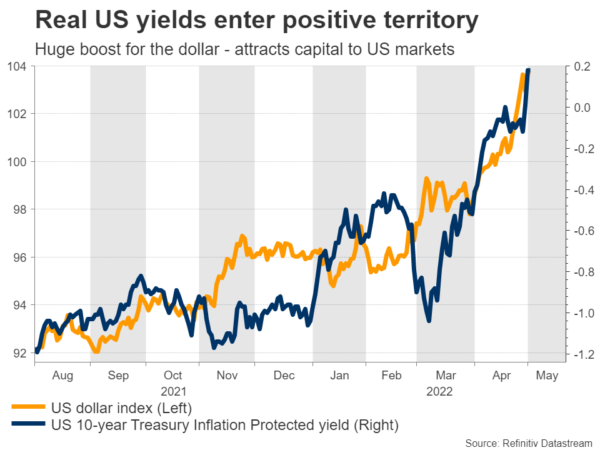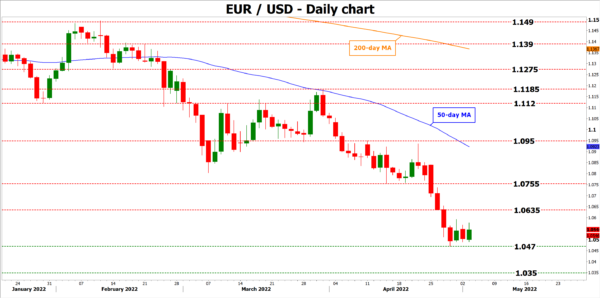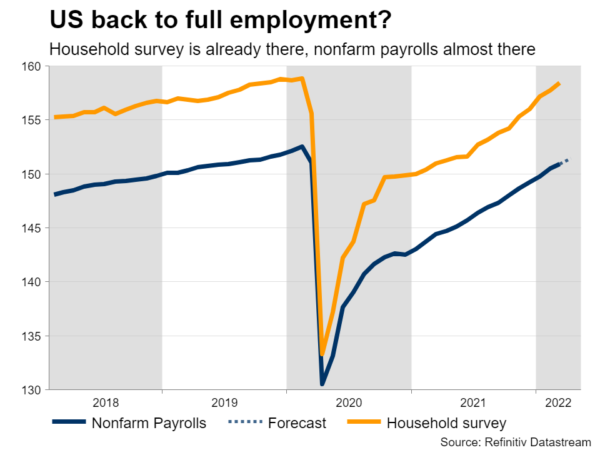The Fed is almost certain to raise interest rates by half a percentage point and begin shrinking its enormous balance sheet when it concludes its meeting at 18:00 GMT Wednesday. Then on Friday, the employment report for April will hit the markets and is expected to reaffirm the strength of the US economy. Overall, the dollar will likely remain king until the economic outlook for Europe, China, and Japan begins to improve.
Fed gets its wish
Fed officials have been talking a big game lately, preparing the markets for a series of rapid-fire rate increases to cool sizzling inflation. Their message has finally gotten across. Ten year real US yields turned positive after a long time as inflation expectations declined, which means that investors are starting to believe the Fed will get the job done.
A half percentage point rate increase is already fully priced in for this meeting, so the market reaction will boil down to the details around the balance sheet reduction process and Chairman Powell’s remarks during his press conference.
It won’t be easy for Powell and his colleagues to outgun market expectations even if they wanted to. The bar has been set quite high with a total of 200 basis points of rate hikes priced in until September. It’s difficult to go any faster than this, otherwise there’s a real risk something breaks – whether it’s the bond market, housing market, or a stock market swimming in leverage.
The Fed wants to avoid sparking panic. With economic growth losing steam, the dollar strengthening so much, and inflation expectations cooling a touch, there’s no great urgency for Powell to ‘go to war’ at this meeting. Instead he might strike a balanced tone, highlighting inflation worries but also noting the risks around growth, especially with Europe and China also slowing.
This may disappoint some US dollar bulls. In this case, euro/dollar could inch higher to test the 1.0635 zone.
Full employment ahead
Then on Friday at 12:30 GMT, the latest US employment report will be released. Nonfarm payrolls are expected to have risen by 400k in April, pushing the unemployment rate down one tick to reach 3.5%.
Such a low unemployment rate was only achieved for a few months before the pandemic – you have to go back to the 1960s to find similar readings. Wage growth is forecast to have remained almost unchanged but with the economy almost back to full employment, wages are likely to pick up soon.
As for any surprises, job market indicators generally favor a strong nonfarm payrolls print. The Markit PMI survey showed that the rate of job creation in April was the strongest in a year while initial jobless claims fell further during the survey week, both pointing to a solid print. A strong report overall could help euro/dollar move back down towards the 1.0470 zone.
There was some cause for concern from the ISM manufacturing survey, where the employment sub-index fell notably. That said, the manufacturing sector accounts for less than 10% of the US workforce, so this signal should be taken with a grain of salt.
Dollar remains king
As for the dollar, it may take a step back this week in case the Fed is not as hawkish as many investors expect, but the overall outlook remains positive. The dollar got here by riding a perfect storm of rising US rates, risk aversion, and storm clouds gathering over every other region.
An energy crisis has brought Europe to its knees, China remains committed to strict lockdowns that will hammer growth, the British pound is trading like a proxy for stock markets, and Japan wants a weaker currency.
Until the outlook for these regions begins to improve, it’s difficult to envision a trend reversal in the dollar – even if the Fed slightly under delivers relative to market expectations. There’s just no real alternative.
















